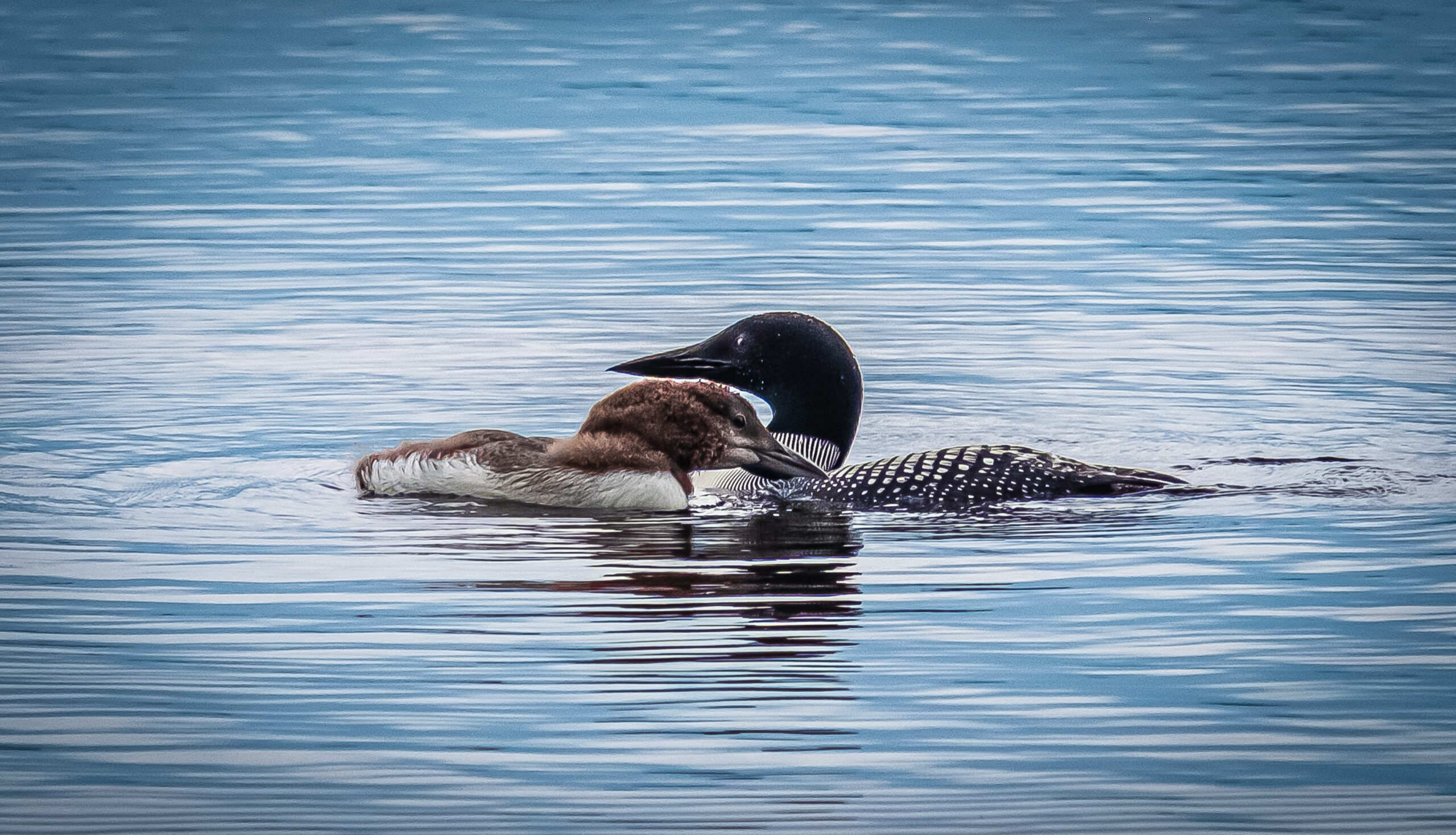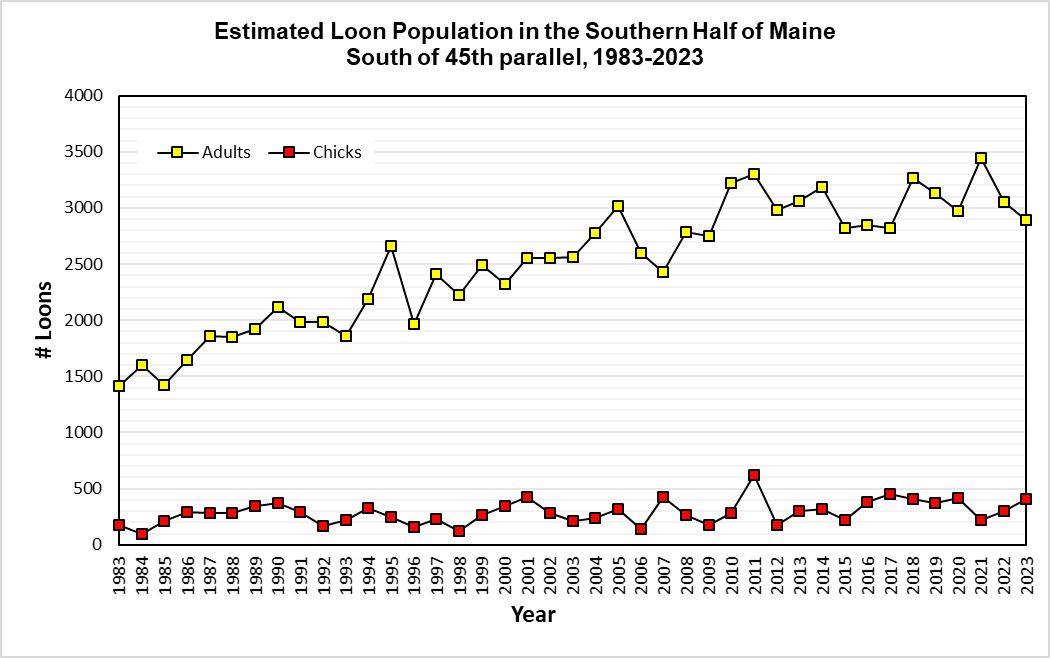
(Above photo: This striking photo was taken by Elizabeth Payne, an annual loon counter; used by permission)
And just like that we have 40 years of loon count data for the state of Maine! On July 15, 1503 volunteer loon counters headed out to 374 lakes to gather important data, allowing Maine Audubon to calculate a population estimate for southern Maine and keep an eye on trends over time.
Although weather, including some pea soup fog in the north, resulted in poor visibility for some, counters still managed to count on the highest number of lakes since the Annual Loon Count began—a great way to commemorate the 40th anniversary of this statewide volunteer effort!
Though the count itself lasts only half an hour, loon count volunteers and coordinators commit to much more than just 30 minutes. From the Rangeley Lakes region to Moosehead and down to Sebago, coordinators are organizing counters on huge lakes, helping assign people to one of many survey areas, conducting outreach, and tallying up their individual lake numbers. Counters are getting out on the lakes earlier than 7 am, making sure their boat tanks are full and scouting locations and boundaries. The continued dedication from loon counters over the last 40 years is a testament to how committed people are to loons and conservation efforts in Maine. Every counter has a unique story about how they became involved or what the loons mean to them—this project is lucky to have such a range of experiences and backgrounds.
So what did the 40th year of the loon count show in terms of numbers? Across the 374 lakes included, counters tallied 2,299 adults and 178 chicks. To determine the population estimate for the southern half of Maine (south of the 45th parallel, where enough lakes are covered by counters to determine a reliable estimate) we estimate the adult and chick numbers across all lakes in the southern half based on a random sample of those actually counted. Based on those calculations, we project a population of 2,892 adults and 411 chicks for the southern half of Maine.
 Let’s focus on the adult numbers first. This is the second year in a row the estimated population has decreased. Should we be worried? Not yet! As you can see from the chart we saw a similar drop in adult numbers between 2005-2007 and again in 2018-2020, but both times were followed by a marked increase in the next year. As a reminder, we are looking at numbers over time, and since the overall trend has continued upwards over the years, the year-to-year fluctuations are not worrisome. Generally, we are looking for changes at a three to five year time frame, so if there happens to be a decrease next year as well, we may start raising some alerts, but we’re not there yet, especially noting the increase in chicks!
Let’s focus on the adult numbers first. This is the second year in a row the estimated population has decreased. Should we be worried? Not yet! As you can see from the chart we saw a similar drop in adult numbers between 2005-2007 and again in 2018-2020, but both times were followed by a marked increase in the next year. As a reminder, we are looking at numbers over time, and since the overall trend has continued upwards over the years, the year-to-year fluctuations are not worrisome. Generally, we are looking for changes at a three to five year time frame, so if there happens to be a decrease next year as well, we may start raising some alerts, but we’re not there yet, especially noting the increase in chicks!
As with the adult numbers, year-to-year fluctuations of the chick population are not unusual but we do love to see the marked increase! In addition, this will hopefully result in higher adult numbers down the road as these chicks reach breeding age (in six or seven years). So let’s celebrate this 113 chick increase, up from 298 chicks estimated in the 2022 count to 411 chicks in 2023, with the understanding that we expect to see these ups and downs.
2023 was a year of celebrations. From 40th Loon Count parties in Manchester and Oquossoc, to new gear (clothing for loon count volunteers is available to purchase until 12/31!), to a celebratory video featuring some dedicated counters and coordinators, we thanked longtime counters and welcomed new loon count enthusiasts and supporters.
Each year we mention there is not enough coverage in the northern portion of Maine (north of the 45th parallel) to confidently provide an estimate of the loon population for that part of the state. However, starting this year we are committed to providing count numbers for the lakes actually counted in the north. Of the 374 lakes counted in Maine, 69 of those were north of the 45th parallel and on those lakes volunteers tallied 522 adults and 31 chicks. This number cannot be used as a straight comparison to the south but it can serve as a reference for loon numbers and northern coverage moving forward. Due to lower human population in the north, in addition to the remoteness of many lakes, it will be difficult to fully cover the north with volunteers but we hope to increase coverage in the future. When the loon count began 40 years ago, we used aerial surveys to count on 100 random lakes in the north to estimate the loon population in the north—so if you’re a pilot and interested in starting this up again, reach out!
And in outstanding news, together with the help of loon counters—who made up many of the 1,000-plus people who signed Maine Audubon’s petition in favor of LD 958—a new law was passed which will phase out the sale and use of painted lead fishing tackle, finally closing a dangerous loophole. Lead poisoning has long been one of the leading causes of death for adult loons in Maine. Common Loons can accidentally ingest lost or discarded lead tackle when it sinks to the bottom of a lake or pond, causing illness and death. Following a five-year phase-out process, it has been illegal to sell and/or use lead sinkers and bare “unpainted” jigs (weighing less than an ounce in weight or measuring less than 2.5 inches in length) in Maine since 2017. Now painted lead jigs within these size and weight limitations will also be phased out, bringing Maine’s waterways one step closer to being safer for loons.
Thank you to all the loon counters, coordinators, volunteers, donors, and staff members who have supported the loon count over the last 40 years. Here’s to many more counts together!
